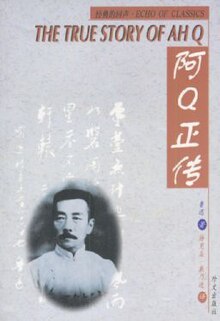The True Story of Ah Q

One of the reprints after 1923 with the author and English title on the cover
|
|
| Author | Lu Xun |
|---|---|
| Original title | 阿Q正傳 |
| Country | China |
| Language | Vernacular Chinese |
|
Publication date
|
1921 |
| Lu Xun | |||||||||
| Traditional Chinese | 阿Q正傳 | ||||||||
|---|---|---|---|---|---|---|---|---|---|
| Simplified Chinese | 阿Q正传 | ||||||||
|
|||||||||
| Transcriptions | |
|---|---|
| Standard Mandarin | |
| Hanyu Pinyin | Ā Q Zhèngzhuàn |
| Wade–Giles | A Q Cheng-chuan |
The True Story of Ah Q is an episodic novella written by Lu Xun, first published as a serial between December 4, 1921 and February 12, 1922. It was later placed in his first short story collection "Call to Arms" (吶喊, Nàhǎn) in 1923 and is the longest story in the collection. The piece is generally held to be a masterpiece of modern Chinese literature, since it is considered the first piece of work fully to use Vernacular Chinese after the 1919 May 4th Movement in China.
It was first published in the Beijing Morning News supplement as a serial. Originally Lu Xun wrote the story under the name "Ba Ren" ("crude fellow"), and so originally few people knew who wrote the novella. The first installment was published on December 4, 1921, and additional installments appeared weekly and/or fortnightly. The final installment was published on February 12, 1922. The story had nine chapters.
The story traces the "adventures" of Ah Q, a man from the rural peasant class with little education and no definite occupation. Ah Q is famous for "spiritual victories", Lu Xun's euphemism for self-talk and self-deception even when faced with extreme defeat or humiliation. Ah Q is a bully to the less fortunate but fearful of those who are above him in rank, strength, or power. He persuades himself mentally that he is spiritually "superior" to his oppressors even as he succumbs to their tyranny and suppression. Lu Xun exposes Ah Q's extreme faults as symptomatic of the Chinese national character of his time. The ending of the piece – when Ah Q is carted off to execution for a minor crime – is equally poignant and satirical.
Both the novella form and the low social station of the protagonist were new in the ancient Chinese literature. But the story consisted of nine serial episodic chapters (an old Chinese method for long folklore 章回體形式, which can consist of hundreds of chapters). This is the only novella published by Lu Xun.
In Chapter One, the author claims ironically that he could not recall nor verify Ah Q's correct name, a claim that gives the character symbolic anonymity. "Ah" (阿) in Chinese is a diminutive prefix for names. "Q" is short for "Quei", which would today be romanized in Hanyu Pinyin as "Guì." However, as there are many characters that are pronounced "quei," the narrator claims he does not know which character he should use, and therefore shortens it to "Q." The deliberate use of a Western letter instead of a Chinese character is a reference to the concepts of the May Fourth movement, which advocated adoption of Western ideas.
...
Wikipedia
